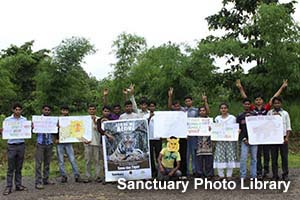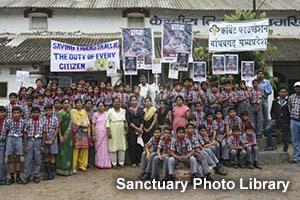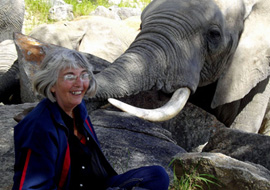The Wild Walk believes that Raj Krishnani, Founder of the initiative 'Save the Tiger' is one of the very few Conservation Warriors in our Country. We bring to our readers, what inspired him to be who he is today – an extraordinary person with the mission to save Tigers.
- Shrilekha Venkateswar | The Wild Walk

How did the
initiative 'Save The
Tiger' blossom? What
does the initiative
do?
Around the Year
2000, there was this
gain in media
coverage about Tiger
deaths in the
Country and once in
a way there were a
few articles
covering about tiger
conservation in the
newspapers but again
there was no idea
about what is going
on in each reserve,
like for example how
many tigers are even
there etc. I was
extremely
inquisitive and
wanted to know more
till until one day,
in the Year 2008, I
learnt about
Facebook. I was told
that there were
immense number of
pages on Tigers and
Tiger conservation.
Excited but to be
soon disappointed to
find that there were
at least 25 to 30
pages on Facebook
called ‘save the
tiger’ etc but were
completely useless,
some did not have
anything, some had
just advertisements
and some were just
posting once in a
way without good
information. That is
when I decided to
take on the job of
creating awareness
for Tigers and on
17th July 2008
formed my page “Save
the Tiger’.
Even today there is
no better medium
than social media to
reach the common
people and Facebook
allows us to reach
so many people
around the world.
Initially it was a
tough job creating
awareness but today
with almost 3.4
million people on my
page, it makes a
good impact to
highlight issues and
get connected to
various parts on the
world and especially
India, where Tiger
conservation is the
need of the hour.
One such programme
which we conducted
was the “Leave Me
Alone’ campaign
along with Bittu
Sahgal – Editor,
Sanctuary Asia
Magazine. The
campaign consisted
of ongoing
activities and
events designed to
aid India’s people
in echoing the
tiger’s plea to
“leave me alone.”
Some of the key
objectives of this
campaign included
six serious steps to
save the tigers
namely - to get
serious about
poaching, making
protected areas
inviolable, to
address habitat
degradation and
fragmentation,
Incentivise and
assist communities
to benefit from
livelihood options
through Community
Nature Conservancies
(CNCs), address
climate change, to
use science as a
management tool.
I also regularly
connect with NGO’s,
Government
Organizations and
conservationists to
help people who are
working ‘mud on
boots’ in our Tiger
reserves by
providing them funds
, materials etc
through direct
sponsorship. We have
a Tiger defender
team, who anyone can
directly support and
contact them for
various needs
through.
 Where do you
think we stand in
terms of tiger
conservation?
Where do you
think we stand in
terms of tiger
conservation?
Well, it is a very
important question
and a very tricky
question to answer.
Fortunately there is
a good momentum from
the Government to
realise about Tiger
conservation and
there are also
efforts being put
through the National
Tiger Conservation
Authority (NTCA);
but we are a very
long long way yet.
The two most
important things
which are our key to
good conservation
efforts are our
forest guards and
awareness to
villages surrounding
the reserves because
if these two are
strengthened there
will be tremendous
decline in
encroachment,
poaching, man –
animal conflicts and
deforestation. How?
If the villagers are
taught about why the
Tigers are important
for our forests and
our survival, they
will understand why
they should not harm
them in anyway. If
there is no chance
of relocation of the
village proper
education and
awareness about
their surroundings
should be given to
them.
A) Encroachment /
Deforestation: Most of
the villages inside the
tiger reserves expand
every year due to some
population explosion or
have people move in from
other villages to work
in towns and cities
nearby. That is when
space becomes necessary
for these people and
unfortunately the forest
cover is compensated for
such issues. New houses
start coming up to meet
the population demand
and this slowly starts
shrinking the boundary
of the Tiger Reserves.
If a village agrees to
the compensation and
relocation from the
Government, it will be
beneficial for both
Tigers and themselves.
Today it is the coal
mines which are the
ultimate threat to Tiger
conservation. Mining
around Tiger Reserves is
disastrous as it
destroys the earth
completely and it takes
years for any forest to
revive, as the soil in
these areas are
completely impure for
vegetation to grow back
again quickly.
B) Poaching: Most of the
general poaching of deer
and wild boar is done by
the people living in and
around tiger reserves.
They do it for their
need of food and
sometimes to kill stray
animals that enter their
fields to graze. Tiger
poaching is also done in
many cases through the
help of a local villager
or informer who helps
these poachers to locate
tigers in the forests as
they are very
informative on the
whereabouts of Tigers.
C) Man - Animal conflict
: A very important issue
because if these
villages are not
relocated there is bound
to be a conflict and
unfortunately its always
the Tiger who is
suffering because there
is a huge outcry to kill
the Tiger once it harms
or kills someone though
it may not be a
man-eater. The
Government though is
currently compensating
for losses of human life
and cattle but
unfortunately even after
the compensation
villagers poison Tiger
kills which leads to a
number of deaths each
year.
D) Forest Guards: The
most important weapon
for Tiger conservation.
Though the Government
has released funds for
conservation, these
guards still do not have
the proper equipment /
materials to tackle
poachers who in turn
have more advanced
weapons than these
guards. Proper
allocation of gear is
required to tackle this
issue upfront. We have a
very dedicated guard
force in our forests who
are working hard day and
night and are nothing
less valuable than our
Army and Navy who are
protecting our National
Animal. They are
motivated and true
warriors they need to be
honored for the
courageous work they all
do.
What are the
changes you see in
people's mind after
Save The Tiger
initiative?
Even before I
started this page, I
used to ask people
what do they know
about Tigers. Some
said beautiful, some
said ferocious,
others found it to
be a predator etc.
But hardly people
said that it was an
endangered species
or a species which
needed to be
protected. They did
not even know that
it is almost at the
brink of extinction.
All they knew was
there are so many
Tigers in the zoo
worldwide so why are
we worried about
Tigers in the wild.
This was the issue
where the page
helped me in
changing their mind
set and I was able
to make them
understand why the
Tiger in the wild is
more important than
the one in the zoo.
Today I am happy
that this awareness
has gone deep and
people are realizing
the connection
between Tigers and
our existence and I
hope I can take this
awareness to a huge
level and educate
each and every
citizen of this
country and make
them realise the
importance of this
cause.
 What are your
biggest concerns for
future? Where do you
think we are heading
towards?
What are your
biggest concerns for
future? Where do you
think we are heading
towards?
Air and Water. They
key to all life. We
are abusing our
environment and
reaching the point
of no return very
soon. We have
contaminated our
rivers, our climate
is changing every
year, and we have
strange weather
patterns already.
Our green cover is
being lost @ 20%
each year and all
this will finally
affect the two
crucial elements in
our life. If we do
not realise the
importance of our
eco wealth, the
dipping stock index
of our woods, the
raging hints from
Mother Nature soon
will definitely seal
our fate. People
like you and me may
have been long gone
but we are leaving a
big burden on the
shoulders on the
generations to come.
They will suffer
ultimately as we
will be leaving them
with only a
materialistic world.
And as the Native
American saying
goes, 'When the last
tree is cut down,
the last fish eaten,
and the last stream
poisoned, you will
realise that you
cannot eat money'.
Do you think a
lot of focus is
given to tigers and
the other species
are slightly
neglected?
I do not completely
agree to this
statement because
Tigers are an
umbrella species,
they are on top of
the food chain and
being the National
animal and its
reputation, it does
demand that
attention. Species
living in Tiger
reserves are
thriving under it.
If you have studied
the rest of the
species which are
under threat are
usually beyond tiger
reserves, mainly
that is because of
poaching and
hunting. For example
the Great Indian
Bustard. If this
species would be
found in Tiger
reserves it would
have been difficult
to poach them
because of the scare
of Tigers. It would
be indirectly
protected.
Today there are a
lot of NGO’s,
conservationists,
and researchers also
working and
educating us on
various other
species. Besides,
slowly we are
realising the
importance of bees
for example which
are wiped out from
cities because of
our cell phone
towers. Definitely
each and every
species is important
to the web of life
and should be given
equal importance.
 What is your
opinion on wildlife
tourism in India? It
is true that a lot
of restrictions have
been imposed in
terms of restriction
in number of
vehicles allowed
inside park,
reducing the tourist
routes etc., but do
you think that is
enough? What other
aspects should the
government implement
for responsible
tourism?
What is your
opinion on wildlife
tourism in India? It
is true that a lot
of restrictions have
been imposed in
terms of restriction
in number of
vehicles allowed
inside park,
reducing the tourist
routes etc., but do
you think that is
enough? What other
aspects should the
government implement
for responsible
tourism?
Wildlife Tourism is
very important for
our country.
Economies of some
countries in Africa
thrive on wildlife
tourism. We need to
learn from them how
they have turned
them into goldmines
and at the same time
respecting the laws
of nature as it is
the only income they
have. Similarly in
India some Reserves
and Sanctuaries play
an important role in
the economy as well
as conservation.
Rules and guidelines
are very important
for us and without
rules, these places
will soon turn into
fish markets and
there would be chaos
inside the parks. It
is necessary to
control the vehicles
inside the park as
sometimes after a
Tiger or Leopard is
spotted they all
cramp up on the
jungle paths making
animals change their
course and sometimes
completely
hesitating to cross
over. Nature should
not be obstructed.
In regards to
tourist routes, yes
definitely some
routes need to be
closed time to time
because there might
be for example a
tigress that might
have just given
birth and would need
privacy because the
cubs will get
affected by the
noise of the
vehicles and
tourists. Also some
routes are banned to
keep poaching under
control and for
safety measures.
The Government has
to ensure that the
guides and the
forest guards are
strict with the
tourists who create
havoc while spotting
animals. Some
tourists will
scream, shout and
even have known to
throw things at
animals. In these
situations strict
action should be
taken towards such
tourists. It has
also come to notice
that a lot of tour
operators are also
breaking the law and
entering restricted
areas of the park to
gain popularity by
getting their
clients exclusive
footage. The other
big problem is the
sudden entry of
Ministry /
Government vehicles
that arrive at the
parks and other
general tourists
have to suffer their
entry because the
quota is over. These
so called VIP menace
is creating a lot of
problems for
tourists who want to
visit the Parks and
Sanctuaries only to
know that there is a
blocked quota for
the VIP’s at the
very last moment.
Not only are these
quotas blocked,
rules and
regulations are also
sometimes amended
for them to make
sure these so called
VIPs get proper
sighting of Tigers
in fear of losing
their jobs or losing
their high posts.
There is a
uncontrolled flow of
VIP tourism in every
reserve which needs
to be checked and
there is also a big
loss of revenue as
they visit these
parks frequently in
good numbers. Some
parks have zones and
fixed routes where
you get entry but
for them the rules
are different
because they prefer
to go on the routes
where the sightings
are better or known
to be better at the
given time.
There is a huge list
of complaints from
tourists who have
been there at the
time these VIPs
invade the parks at
any given time. Hope
there is a strict
law in place soon to
curb this menace. If
we need to make
these parks
completely tourist
friendly, then there
should not be any
disappointments
caused to them, as
they spend a great
deal of money and
they should
influence others to
visit these parks
and help grow our
revenue.
 This is the
question we ask
people in our
profession. As India
is heading towards
eco tourism, what is
your opinion on Eco
tourism and how do
you think our
country will
perform? What are
the likely problem
we might be facing?
This is the
question we ask
people in our
profession. As India
is heading towards
eco tourism, what is
your opinion on Eco
tourism and how do
you think our
country will
perform? What are
the likely problem
we might be facing?
Eco tourism is the
future. Today we
have resorts
mushrooming all over
the country and
specially in virgin
tourist spots to
create new
destinations for
tourism. Already
where there are
resorts there is a
huge amount of waste
disposal etc taking
place. Each and
every hotel/resort
in this country
which are located in
eco sensitive areas
should be converted
into Eco hotels with
sustainability. Some
important factors to
consider are
> Build
environmental and
cultural awareness
through programs
> Sensitivity towards,
and appreciation of,
local cultures,
biodiversity and nature
> Support for local
conservation efforts
likes NGO's in their
area
> Sustainable benefits
to local communities by
giving them jobs
> Local participation in
decision-making to make
sure unity is maintained
> Educational components
for both the traveller
and local communities.
These key factors
will boost eco
tourism and help
communities benefit
and sustain
themselves. India is
not performing too
badly yet but if the
Government boosts
eco tourism like
they have in other
countries, things
could change a lot.
Awareness has
created a genre of
tourist who like
such places and are
willing to pay the
extra rupee to stay
at such places.
The rules and
regulations still
need to get stronger
and whip the
offenders who are
abusing the ecology
at sensitive places.
The Government has
to implement open
policy for such
places under strict
supervision.
Investment is
another core issue;
the Government has
to have relaxed bank
loan schemes.
Another problem
faced is about
proper guidance of
waste disposable
which is still
lacking in these
places.
 How has the journey
with Save The Tiger
been? Please tell us
about some of the
best moments you
have had.
How has the journey
with Save The Tiger
been? Please tell us
about some of the
best moments you
have had.
The journey has been
fantastic, happy,
sad, surprising.
There have been so
many mixed emotions
involved in this
journey. I have been
very fortunate to
know so much about
Tigers and come
across wonderful
people working in
conservation and
committed to the
cause. When you are
working with and for
Tigers, it is
difficult to choose
good moments. The
launch of the 'Leave
Me Alone campaign'
was one great
achievement where
along with the
Government of
Maharashtra,
instigate the CBI
inquiry for poaching
cases and
fortunately it has
proved results. Also
the campaign had
reached the IIFA
awards where a lot
of stars gave an
awareness message on
the same.
We are now planning
the second impact
for the LMA campaign
and this time we are
going in a big way
to get support for
Tigers through
various sources and
hopefully will
launch it by April
this year. Since it
is in the developing
stages I cannot
really comment on
the event.
I personally have
always enjoyed your
sense of humor. Most
of the post that you
share on your
'personal' Facebook
is very hilarious
and witty.
Thank you. Well, it
is not me but my
girlfriend
(imaginary) who
keeps everyone
entertained.
Basically if you
want, you can find
something funny in
everything. I just
take for instance
something I am
reading, I twist
them into jokes and
create situations of
how my girlfriend
would think or say
at that moment.
These twists create
good humor and I am
happy everyone
enjoys them. This
humor thing actually
happened because
when I do my
research, I come
across a lot of bad
news and unpleasant
pictures which make
me sad, so to have a
change of mood, I
add humor to my
personal profile and
that is the reason
my profile is not
much about
conservation unlike
my pages - 'Save the
Tiger and Save the
Leopard'.
 Undoubtedly you're a
conservation
warrior. How does
this feel and how
big a responsibility
is this?
Undoubtedly you're a
conservation
warrior. How does
this feel and how
big a responsibility
is this?
It is absolutely
frightening and
scary to have a part
of the
responsibility. I
never thought my
page would become
the ultimate
platform for
awareness in this
world. It has
transformed my life.
I am very nervous
about the future of
tigers but at the
same time very
hopeful. Today
everyone from who’s
who in Tiger
conservation,
photographers, and
NGO's are connected
with my page and it
is very important to
connect with them to
know about the
current situation of
Tigers in this
country.
Every single word
put on the page is
important. I have to
make sure I give
correct information
and pass on the
right conservation
message to the
millions out there.
It is a very
difficult job
sometimes answering
to so many
individual people,
their queries, and
inquisitiveness and
sometimes convert
their hate for
Tigers into love by
explaining them
about why we are
saving Tigers. So
far so good and I
hope to do this and
want to see our
Tigers live forever.
A lot of preference
is given to the
forests in central
or Northern India in
terms of tourism or
facilities for
tourists by
government or even a
lot is written about
them. Very less is
spoken about the
forests in South
India, which has a
great wildlife
including healthy
population of
Tigers. Most of the
documentary movies
are also shot on
forests up north.
What do you think of
this and why is this
happening?
When it comes to
preference or
tourism facilities,
the rules are same
for every
destination.
According to me the
first impact came
from people like the
late Fateh Singh
Rathore and Billy
Arjan Singh who were
brilliant in passing
on the messages of
conservation to
everyone. The other
reason was Jim
Corbett who was very
popular since the
British rule and his
stories about Tigers
and description
about the landscapes
etc created a lot of
attraction for
tourists alike.
The jungles of South
India are in fact
beautiful and I have
spent more time in
the jungles of
Bandipur, Mudumalai
and Nagarhole than
in the north. The
Nilgiris have their
own beauty and if
you see today there
is a lot of coverage
like photographs,
articles and news
flowing through
South India. Media
is a power tool and
today I think there
is equal importance
given to all the
jungles of India.
 How important it is
to involve common
people in the act of
conservation?
How important it is
to involve common
people in the act of
conservation?
The common people
are the backbone of
conservation. To
deal with an issue
it is important to
know the cause of
its destruction.
Only then can we
find solutions. When
the people of a
nation realise the
importance of a
particular problem,
they roar together.
That way, we can
make sure that we
are involving
millions of
supporters, and
bringing pressure
from all those
millions on the
authorities who are
actually appointed
to protect tigers.
The Government will
have to wake up and
get more serious.
The Tiger is our
national animal, our
pride, and we do not
want to lose it to
poaching and habitat
loss. If God has
given us the ability
to destroy, he has
also given us the
power to protect and
we must and will
protect what we
love. Issue like
aids and polio are
today in control
because of awareness
and this was only
possible because the
common man
understood the
importance of the
situation. Similarly
it is very important
for every citizen of
this country to know
why we need to Save
the Tiger and that
will immensely help
with all the
collective efforts
of everyone.
 Tiger population as
per latest census?
The status and
future?
Tiger population as
per latest census?
The status and
future?
We lost 66 Tigers
last year and that
is a very bad figure
with all the
conservation efforts
being put in. There
are still many
unprotected areas
where poaching is
happening that we
are unaware of. If
the Government
declares these
sensitive areas
where there are
tiger population in
small pockets, it
will be possible to
raise these numbers
faster every year.
Though there is a
big cheer to the 30%
plus increase in
population of Tigers
in India, taking the
figure close to
2226, I personally
feel there should be
more Tigers because
there are places
which are still not
announced under
Protected Areas
(PA), are not
counted. If the
Government takes
quick measures to
give them a PA
status, soon things
can be much brighter
than expected. The
other issue is
declaring green
ground for the cats,
because cats need
space for their
territories and the
Government has to
chalk out new areas,
clear corridors
which should be a
priority issue and
see that quick
relocation of
villages are done. I
am completely
satisfied by the
method used for
counting the Big
cats and new
technology will soon
help us coming close
to accurate numbers.
Note: The above
answers, opinions
and suggestions are
completely from Mr.
Raj Krishnani,
Founder of the
initiative Save the
Tiger












